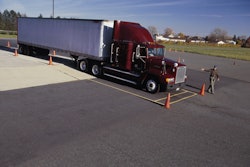Trucking news and briefs for Tuesday, Oct. 22, 2024:
Cargo theft continued to increase in Q3
The recent trend of increasing cargo theft continued in the third quarter of 2024, according to cargo theft recording firm CargoNet.
CargoNet’s analysis of third-quarter cargo theft trends found a 14% increase over the same period a year ago, with 776 recorded cargo theft events across the U.S. and Canada. The total value of those stolen goods was $39 million for the quarter.
While theft activity was up significantly year-over-year, the number of theft incidents did decrease slightly, by 1.6%, from the second quarter of the year. The firm noted, however, that it expects that gap to close with delayed reporting.
Compared to the third quarter last year, there has been a shift in targeted commodities. Thieves are not focusing as much on solar panels, motor oils and energy drinks as they were a year ago. There has been increased focus, however, on footwear, computers, high-end audio systems and hard liquor.
 Cargo theft incidents in California, Texas and Illinois represent more than half of all theft recorded in the third quarter, CargoNet reported.CargoNet
Cargo theft incidents in California, Texas and Illinois represent more than half of all theft recorded in the third quarter, CargoNet reported.CargoNet
[Related: The four keys to combating cargo theft]
The primary drivers of cargo theft continue to be organized crime groups specializing in strategic forms of cargo theft that typically involve some form of document fraud, identity theft, and intent to steal the property they are being entrusted to transport, CargoNet added.
One tactic that has seen increased usage is sophisticated phishing schemes in which bad actors attempt to gain unauthorized access to motor carriers’ email accounts. They then use those emails to bid on loads and bypass compliance checks. CargoNet said this method has grown in popularity in response to much of the industry instituting policies that rate confirmation documents should only be sent to official emails.
Another strategic cargo theft tactic being used is purchasing motor carrier authorities. Previously centered around recently purchased authorities in California, organized crime groups are now primarily interested in authorities in states not thought to be high-risk for cargo theft, after many companies have instituted policies that they will not accept new carriers from the California into their network.
Finally, organized crime groups are using enhanced evasion techniques, such as switching license plates, driver’s licenses, and truck and trailer numbers between pickups to combat growing reliance on publicly available FMCSA vehicle inspection data. CargoNet said multiple pickups are being arranged in multi-day crime sprees, and stolen shipments are being staged at central collection points so that malicious actors can focus on obtaining as many loads as possible before the industry learns of their criminal activity.
[Related: The Cargo Theft Playbook: Essential tips to prevent freight loss]
New Saia terminals open in Ohio, Kentucky
Saia Inc. (CCJ Top 250, No. 19) announced Monday that Saia LTL Freight is continuing its nationwide expansion with the opening of three new terminals this month.
On Monday, a new facility opened in Akron, Ohio. Two additional terminals are slated to open on Oct. 28 in Bowling Green and Paducah, Kentucky. These new locations will enhance service in these regions by reducing transit times and freight handling, the company said.
“Opening these terminals in Ohio and Kentucky will improve service for our customers, allowing us to deliver freight faster,” said Vice President of Operations Jared Mull. “These additions will help us reduce transit times and improve freight handling as we remain committed to providing the highest level of service to businesses and communities throughout the region.”
The new facilities will bolster Saia’s nationwide network, offering more seamless service in those markets. Although Saia has serviced these areas, the new terminals will provide increased capacity and better freight handling, which translates into even higher service standards for customers.
Roadrunner launches outbound service from San Antonio, Laredo
Roadrunner (CCJ Top 250, No. 106) has launched outbound service from the highly strategic Texas markets of San Antonio and Laredo, the company announced last week.
Roadrunner's LTL network is uniquely positioned to service the cross-border shipping needs for manufacturing, assembly and distribution required by consumer, e-commerce, industrial, automotive and retail importers from Mexico, the company said.
Roadrunner's business decision to focus only on LTL and to improve its operations and linehaul network by moving freight long haul, metro-to-metro direct over the road has been hugely successful for the company. The reduced rehandling of freight in its network due to loading and line hauling direct to the service centers has resulted in an extremely low exceptions rate.
"We made a decision to streamline our operations, digitize our network and embark on a relentless pursuit of service excellence,” said Tomasz Jamroz, Roadrunner's Chief Operating Officer. “We transformed Roadrunner into an organization that relies on data-driven decision-making while prioritizing service, quality and speed. That effort has begun to pay off. Opening new outbound lanes from Laredo, the fastest growing inland port in the U.S., to every end point across our national footprint, reinforces our confidence in Roadrunner's service capabilities and demand for reliable LTL transportation.”
[Related: Roadrunner expands LTL services out of Seattle]
Mirror-alternative camera company seeks waiver extension
Vision Systems North America (VSNA) is petitioning the Federal Motor Carrier Safety Administration for a renewal of its existing waiver allowing motor carriers to operate trucks with the company's Smart-Vision high-definition camera monitoring system (Smart-Vision) installed as an alternative to the two rear-vision mirrors required by the Federal Motor Carrier Safety Regulations (FMCSRs).
VSNA was previously granted an exemption for the period of Jan. 15, 2020, through Jan. 15, 2025, and is seeking a five-year renewal.
The company said its camera system meets or exceeds visibility requirements in the federal regulations due to increased field of view compared to conventional mirrors, increased image quality, a fail-safe design and reduced driver fatigue as a result of less head movement.
In granting the original exemption, FMCSA noted VSNA’s Smart-Vision system eliminates blind spots on both sides of the vehicle, expands the field of view by an estimated 25% and uses high-def cameras and monitors that include features such as color night vision, low light sensitivity, and light and glare reduction that together help provide drivers with improved vision in the field of view when compared to traditional rear-vision mirrors.
In requesting the renewal, VSNA said approximately 700 CMVs are currently equipped with the Smart-Vision system in North America, adding that it expects an additional 1,500 CMVs will be equipped with the technology by 2025.
FMCSA is asking for comments on the request, which can be filed here through Nov. 18.














